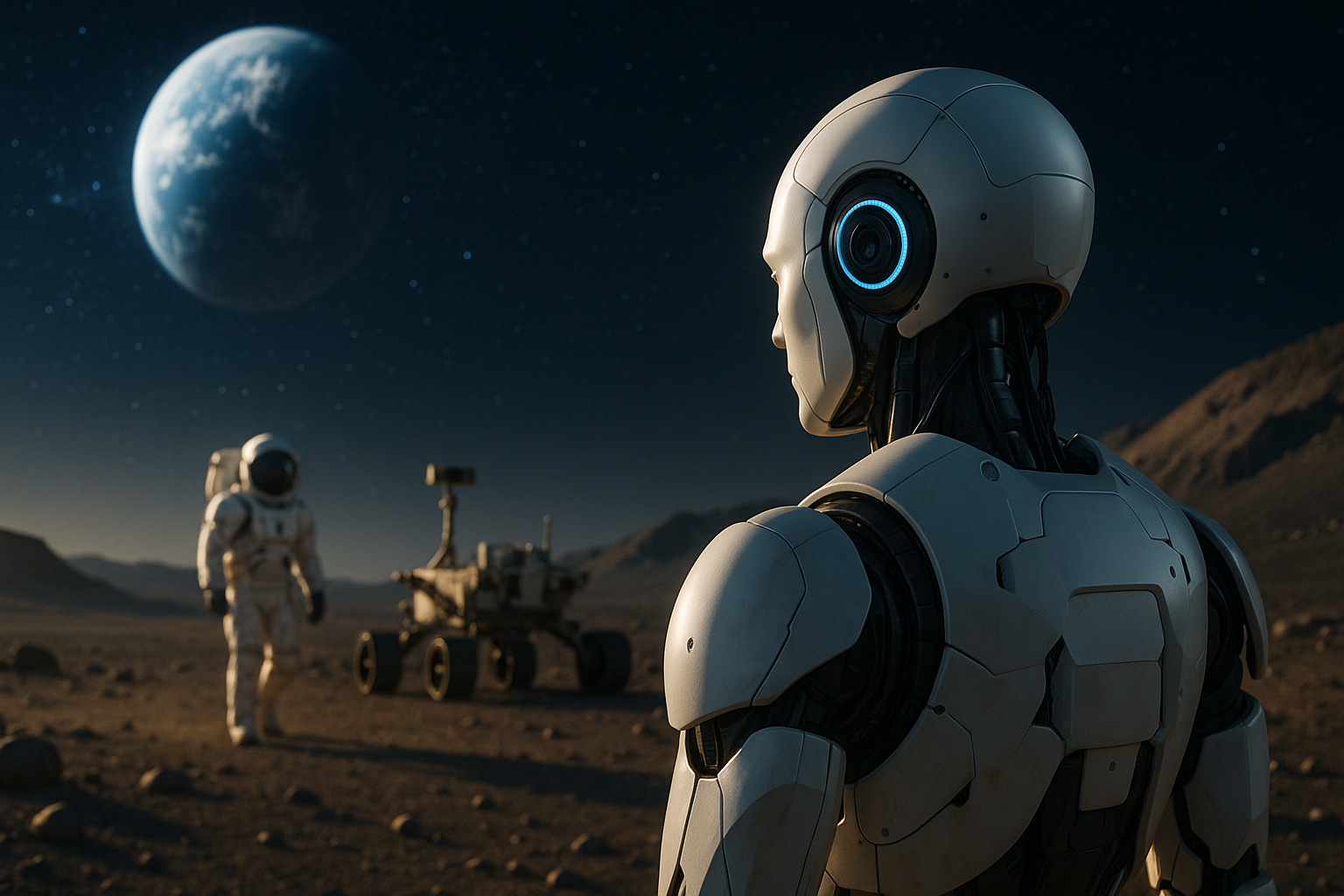Table of Contents
- AI: The New Frontier of Space Exploration
- Historical Context: From Basic Automation to Cognitive Systems
- AI in Spacecraft Autonomy
- AI-Powered Planetary Rovers and Surface Exploration
- AI in Space Habitat Systems and Life Support
- AI for In-Situ Resource Utilization and Space Manufacturing
- Human-AI Collaboration in Space Missions
- Ethical Considerations of AI in Space
- Technical Challenges and Limitations
- Future Prospects and Roadmap

Beyond Earth: How Artificial Intelligence is Shaping the Future of Space Exploration
Published on: May 17, 2025
AI: The New Frontier of Space Exploration
For centuries, humanity’s fascination with the cosmos has driven explorers to push beyond known boundaries, seeking to understand distant worlds and unlock the mysteries of our universe. In recent decades, advances in robotics and computing have enabled ever-more ambitious space missions, yet the true game-changer of the 21st century is artificial intelligence (AI). By harnessing machine learning algorithms, neural networks, and autonomous decision-making processes, AI is transforming every aspect of space exploration. From optimizing spacecraft trajectories to guiding autonomous rovers across alien terrain, artificial intelligence brings unprecedented capabilities—allowing missions to operate with minimal human intervention, adapt to unexpected challenges in real time, and sift through colossal volumes of data faster than any human team. As agencies like NASA, ESA, and private companies such as SpaceX and Blue Origin chart the next frontier, AI stands at the core of their strategy, augmenting human ingenuity and propelling exploration into realms once deemed science fiction. This article delves into the multifaceted applications of AI in space, examines ethical implications, and considers the roadmap ahead as we prepare for deeper, longer, and more complex missions beyond Earth’s orbit.
Historical Context: From Basic Automation to Cognitive Systems
Early space probes relied on pre-programmed instructions and basic automation to perform their tasks. For example, the Voyager spacecraft of the late 1970s followed carefully scripted commands to capture images of the outer planets, while the Mars Pathfinder mission in 1997 used simple autonomy to navigate short distances on Martian soil. Over time, computational power aboard spacecraft has increased dramatically, enabling real-time onboard data processing. However, it was only in the last decade—with breakthroughs in machine learning and neural network architectures—that truly cognitive systems became feasible in space applications. Modern deep-learning algorithms can detect anomalies in sensor data, identify geological features from images, and even predict system failures before they occur. These capabilities mark a shift from reactive automation—where a system follows predetermined rules—to proactive intelligence, where the spacecraft learns from its environment and optimizes its behavior. This evolution reflects broader trends in AI research, where methods once confined to data centers on Earth are now miniaturized and ruggedized for deployment in harsh extraterrestrial environments.
AI in Spacecraft Autonomy
One of the most critical applications of AI in space lies in spacecraft autonomy. When communication delays stretch to minutes or hours—as is the case for probes operating near Mars or the outer planets—ground-control teams cannot micromanage every maneuver. AI-driven autonomy allows spacecraft to make instantaneous decisions: adjusting their attitude to maintain stable pointing, selecting optimal imaging targets, and even routing around hazards. For example, NASA’s Deep Space Autonomous Landing system uses machine-vision algorithms to identify safe touchdown zones in the final landing phase, diverting the lander away from boulder fields or steep slopes without waiting for human approval. Similarly, autonomous navigation systems employing Kalman filters enhanced by machine learning refine a spacecraft’s understanding of its position relative to celestial bodies, enabling precision maneuvers such as asteroid flybys or orbital insertions around distant moons. By reducing reliance on Earth-based commands, AI autonomy cuts mission costs, increases safety margins, and opens the door to more complex multi-body trajectory designs—crucial for missions venturing into the far reaches of our solar system and beyond.
AI-Powered Planetary Rovers and Surface Exploration
On the surfaces of Mars, the Moon, and potentially icy worlds like Europa, rovers act as our robotic surrogates—navigating treacherous terrain, conducting scientific experiments, and relaying data back to Earth. The next generation of planetary rovers leverages AI for path planning, obstacle avoidance, and scientific target selection. Machine vision systems interpret LIDAR and stereo-camera data to build 3D terrain models in real time, enabling rovers to autonomously choose routes that minimize the risk of wheel entrapment or rollover. Beyond navigation, onboard AI algorithms can analyze spectroscopic readings and imagery to prioritize sample collection—focusing limited resources on the most scientifically promising sites. For instance, an AI agent could detect mineral patterns indicative of past water activity, prompting the rover to deploy its sampling arm for closer investigation. These intelligent behaviors maximize scientific return and extend mission lifespans, as the rover conserves energy by avoiding unnecessary detours and optimizes its schedule autonomously when solar power levels fluctuate.
AI in Space Habitat Systems and Life Support
Long-duration missions—whether aboard the International Space Station, planned lunar habitats, or crewed voyages to Mars—rely on life-support systems that must function flawlessly under variable conditions. AI enhances environmental control and life support (ECLS) by continuously monitoring parameters such as oxygen levels, carbon dioxide concentration, humidity, and microbial counts. Predictive maintenance algorithms analyze sensor trends to forecast equipment failure—alerting crew and ground teams well before a critical breakdown occurs. During deep-space missions, where resupply is impossible, AI can optimize resource consumption, adjusting water reclamation and air-filtration cycles to match crew activity patterns. Additionally, machine learning models support personalized health monitoring, detecting subtle changes in astronauts’ vital signs that may indicate the onset of radiation sickness or bone density loss. By integrating biological, mechanical, and environmental data streams, AI empowers autonomous habitat management—ensuring crew safety and comfort on multi-year expeditions.
AI for In-Situ Resource Utilization and Space Manufacturing
One of the transformative frontiers in space exploration is in-situ resource utilization (ISRU)—the ability to harness local materials for construction, fuel, and life-support consumables. AI facilitates ISRU by controlling robotic mining operations, sorting regolith, and optimizing extraction processes. Computer vision systems distinguish target minerals from native soil, directing autonomous excavators to high-yield zones. Machine learning algorithms adjust chemical processing parameters—temperature, pressure, reactant ratios—in real time to maximize oxygen extraction from lunar or Martian regolith. On the manufacturing front, AI-driven additive manufacturing systems produce spare parts on demand, eliminating reliance on Earth-launched spares. Neural networks predict printing outcomes based on material properties and environmental conditions, dynamically tuning print paths to ensure structural integrity. By enabling closed-loop resource cycles and agile manufacturing, artificial intelligence paves the way for self-sustaining outposts and interplanetary cargo hubs.
Human-AI Collaboration in Space Missions
Even as autonomous systems take on more responsibilities, human expertise remains essential for strategic planning, ethical oversight, and complex problem-solving. AI serves as an intelligent assistant—synthesizing mission telemetry, highlighting anomalies, and suggesting corrective actions for flight controllers and astronauts alike. Collaborative interfaces employ natural-language processing (NLP) to enable conversational queries: a crew member can ask the habitat AI, “What’s causing the rise in cabin CO₂ last night?” and receive a detailed, data-backed explanation. Augmented reality (AR) headsets merge AI-generated schematics with real-time visuals, guiding astronauts through intricate repairs or scientific procedures with step-by-step prompts. This symbiosis—combining human judgment with machine precision—enhances decision quality under pressure and fosters trust in autonomous systems. As missions grow more distant and communication delays increase, seamless human-AI collaboration will be critical for maintaining operational effectiveness and crew morale.
Ethical Considerations of AI in Space
With great power comes great responsibility. Deploying AI in space introduces ethical questions that demand careful consideration. Autonomous weaponization of space assets, unintended biases in AI decision-making, and the potential for AI misinterpretation of ambiguous data are just a few concerns. Who is accountable if an AI-driven spacecraft damages a foreign nation’s satellite or crashes on a celestial body, contaminating pristine environments? Ensuring transparency in algorithm design and implementing robust fail-safe protocols are essential steps. International treaties and regulatory frameworks must evolve to address AI governance in space—defining acceptable behaviors for autonomous systems, establishing data-sharing standards, and protecting celestial heritage sites from irreversible impacts. By embedding ethical principles at the core of AI development, the space community can harness these technologies responsibly—advancing exploration while safeguarding the interests of all humankind.
Technical Challenges and Limitations
Despite its promise, AI in space faces formidable technical hurdles. Radiation hardening of processors lags behind terrestrial chip innovation, limiting the complexity of onboard neural networks. Bandwidth constraints between spacecraft and ground stations restrict the volume of data available for model training and validation. Energy budgets aboard solar-powered platforms constrain continuous AI operations, requiring careful power management. Moreover, the “black box” nature of deep-learning models complicates anomaly analysis—making verification and validation (V&V) processes more demanding for mission-critical functions. Addressing these limitations involves cross-disciplinary collaboration: developing novel radiation-tolerant AI accelerators, creating efficient compression techniques for data transmission, and pioneering explainable AI (XAI) methods that provide interpretable rationales for autonomous decisions. Overcoming these challenges will be key to realizing the full potential of AI in space.
Future Prospects and Roadmap
Looking ahead, the synergy of AI and space exploration promises even more profound breakthroughs. Swarms of intelligent micro-landers could survey multiple regions of icy moons simultaneously, streaming curated data back to Earth with only high-level directives. Quantum-enhanced machine learning may unlock new computational paradigms—enabling in-flight optimization of mission trajectories through complex gravitational fields. On the human frontier, neuroadaptive interfaces could allow astronauts to “think” commands to spacecraft or drones, streamlining interactions and reducing cognitive load. Cross-planetary AI networks might orchestrate resource sharing between lunar, Martian, and orbital installations—forming the backbone of an interplanetary economy. To fulfill this vision, investment in AI education, deep-space testing facilities, and international collaboration will be essential. By charting a strategic roadmap—balancing innovation with rigorous risk management—the space community can ensure AI evolves from a tool into a trusted partner for exploring the cosmos.
Artificial intelligence stands poised to revolutionize space exploration—offering the autonomy, intelligence, and adaptability required for the next generation of missions. From autonomous spacecraft and planetary rovers to data-driven astronomy and ethical governance, AI permeates every facet of the journey beyond Earth. By embracing AI responsibly—addressing technical challenges, ethical considerations, and collaborative frameworks—we can extend humanity’s reach into the solar system and beyond. As we prepare to return to the Moon, set foot on Mars, and probe the outer planets, AI will be our guide, our sentinel, and our catalyst—propelling us ever deeper into the final frontier.
